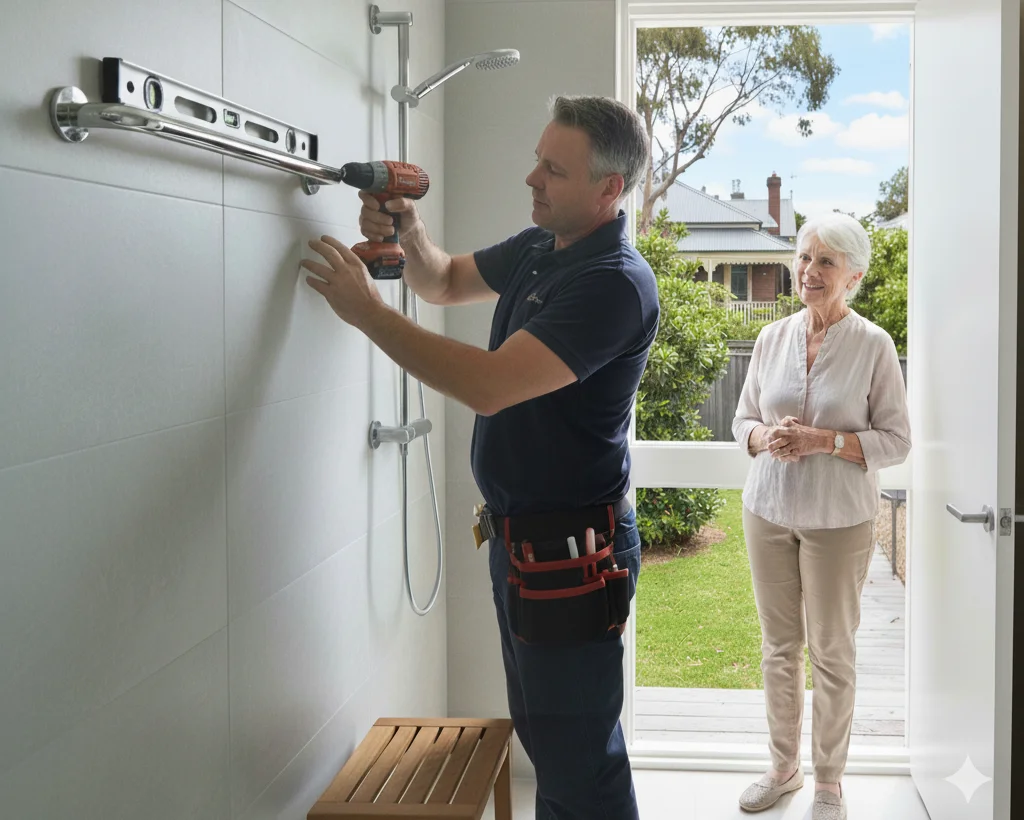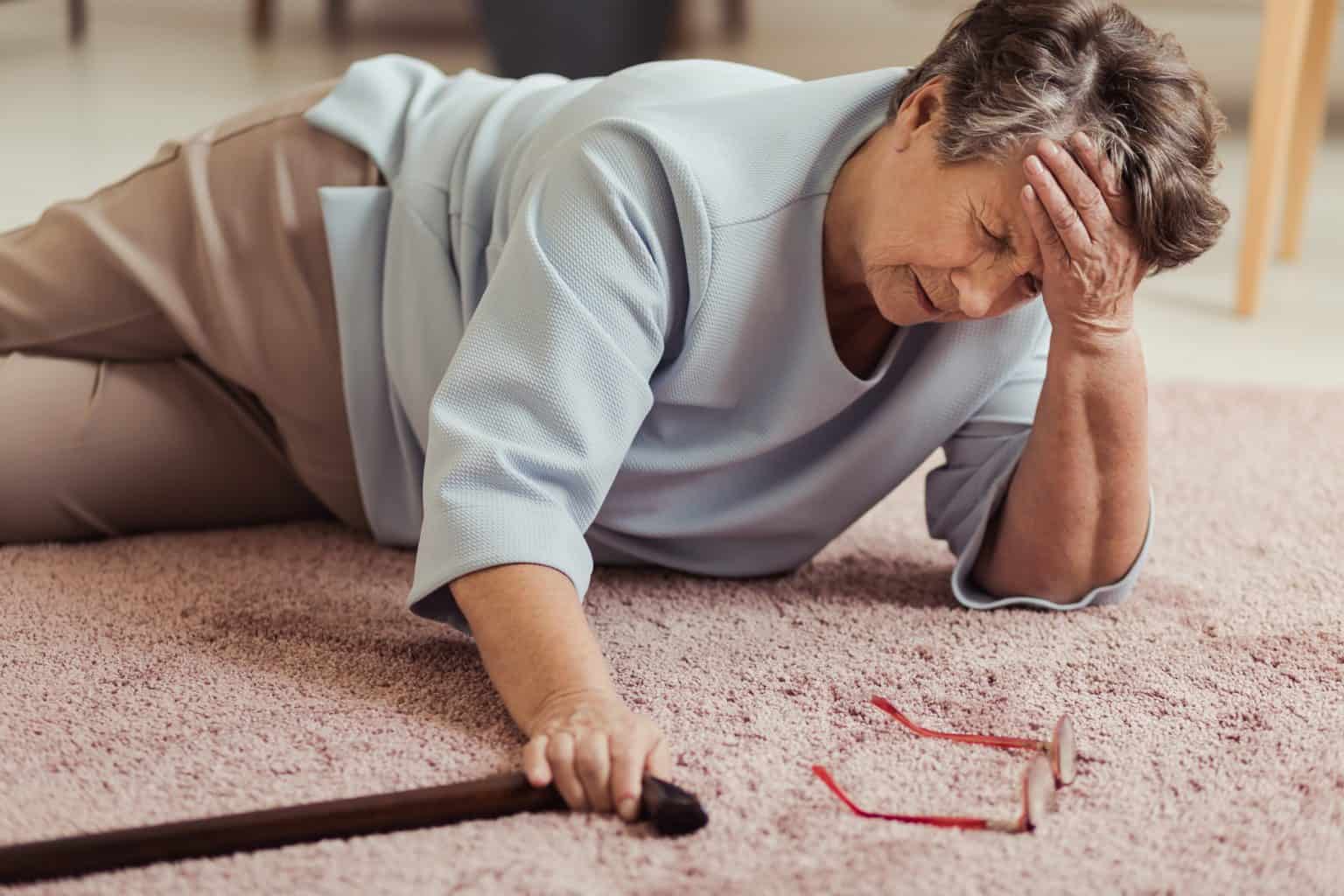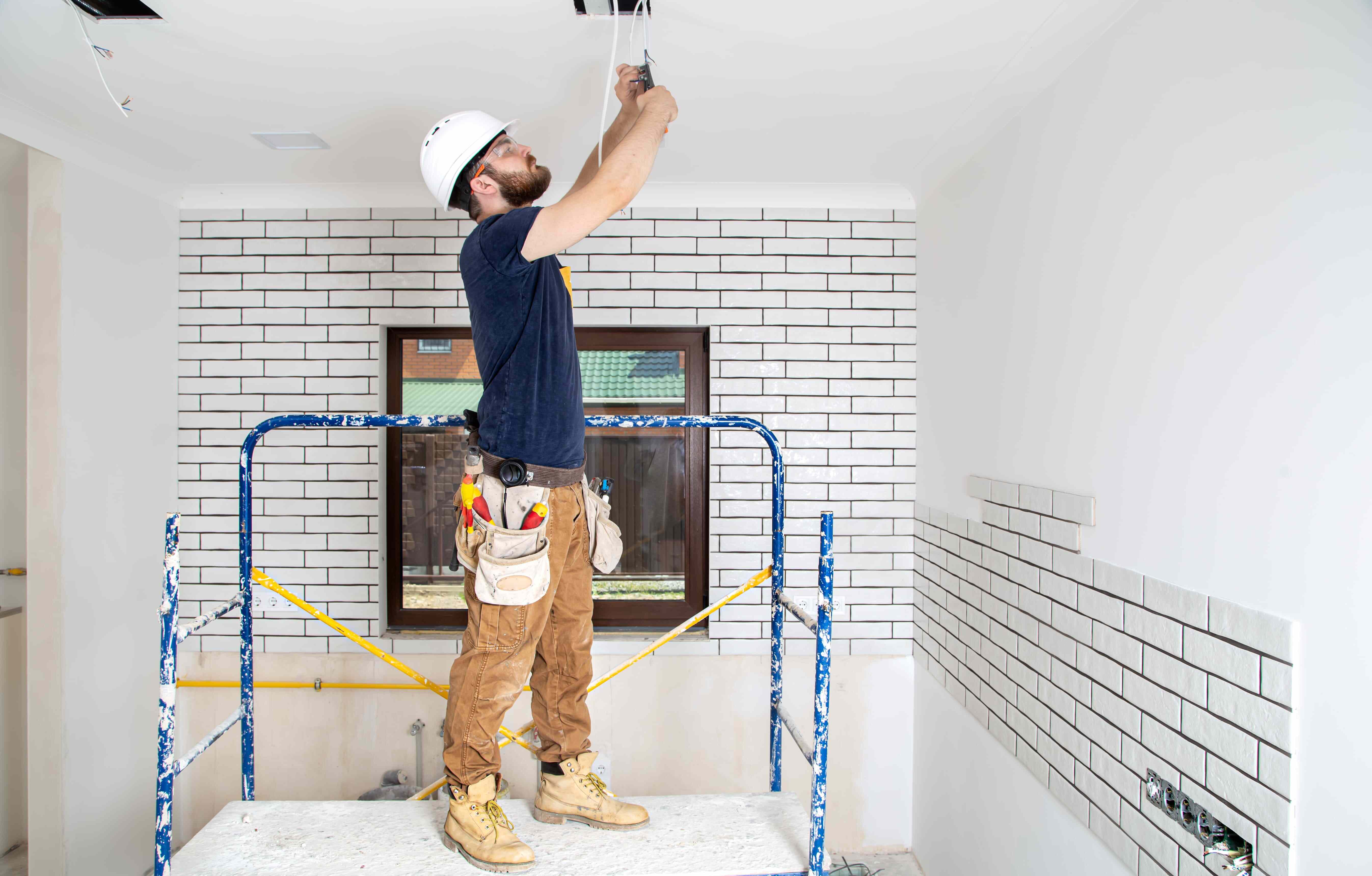1. The Intersection of Design and Longevity: A Melbourne Perspective The narrative of interior design in Melbourne is undergoing a sophisticated transformation, moving away...
Grab Bar Installation for Seniors: Reduce Falls at Home
Fall prevention isn’t exactly a riveting dinner‑party topic—but it should be. Every day, more than 400 older Australians are admitted to hospital because of a fall. In fact, falls were the leading cause of injury hospitalisations in 2023‑24 and the leading cause of injury‑related deaths in 2022‑23.
That’s not just a statistic; it’s your mum, your favourite uncle, or perhaps even future you. When you realise that around one in four people over 65 have at least one fall each year, suddenly grab bars don’t seem like an optional extra—you begin to see them as stylish yet lifesaving accessories.
The Silent Epidemic: Why Falls Matter
Falls aren’t simply accidents; they’re indicators of changing strength, balance and environment. The impact isn’t just physical. A fall can trigger fear, depression and loss of confidence.
Beyond personal distress, fall injuries cost Australia’s health system billions annually. These numbers make a compelling case for proactive prevention, particularly in Melbourne where stylish mid‑century homes can hide hazards like slippery tiles, steps and narrow corridors.
Why Focus on Grab Bars?
Of all the home modifications available, grab bar installation for seniors consistently ranks among the most effective. Bathroom changes—especially grab bars and sturdy stair railings—had the greatest impact on reducing falls and caregiver burden.
Grab bars aren’t just functional; when chosen thoughtfully, they blend seamlessly into modern bathrooms and living rooms while providing essential stability.
Understanding Grab Bars: More Than a Hospital Handrail
Grab bar installation for seniors doesn’t mean sacrificing aesthetics. Today’s bars come in chic finishes like brushed brass, matte black, and powder‑coated hues. Rails should support adequate weight and feature comfortable diameters for gripping.
Bars are available in standard lengths (300 mm, 450 mm, 600 mm, and 900 mm) but can be customised to span wall studs. The takeaway? Choose a bar that’s easy to grip, supports your weight, and matches your interior style.
Types of Grab Bars
Different orientations serve different purposes:
- Horizontal bars – help with sitting or standing.
- Vertical bars – assist pulling yourself up.
- Angled or L‑shaped bars – offer a blend of push and pull.
- Drop‑down rails – fold out from the wall when needed, great for compact bathrooms.
For a home in Melbourne, think about how each room is used. Do you have a sunken living area with steps? A stylish hardwood rail could prevent missteps while blending with your timber floors.
Where to Install Grab Bars
Successful grab bar installation for seniors involves thinking like an occupational therapist. Let’s explore the prime locations.
- Bathroom & Shower: Bathrooms are high risk because water and soap make surfaces slippery. Install a horizontal bar 680–820 mm above the floor near toilets. In showers, place a bar 200 mm above a shower chair and another at 1000 mm for standing users. For baths, position a horizontal bar 75–100 mm above the rim and a vertical bar near the taps to aid entry and exit.
- Stairways & Hallways: Stair rails should be 865–1000 mm above the stair nosing and extend 300 mm beyond the top and bottom steps. Even a single step into a sunken lounge can become hazardous; a discreet rail prevents missteps.
- Entrances & Exits: A vertical rail at the doorframe about 790 mm above the higher floor level helps with stepping in or out. For Australian homes with raised porches, this small addition can make all the difference.
- Bedrooms & Living Rooms: A bar by the bed aids standing. In open‑plan living areas, rails near transition points (e.g., between hardwood and tile) provide subtle stability.
- Outdoor Paths & Garages: Don’t neglect the garage or back deck. A vertical rail by the door helps when carrying groceries or navigating wet paving.
Installation 101: Heights, Clearances & Fixings
Getting the placement right is essential; this isn’t a DIY job for the faint‑hearted. Grab bars need secure fixing to withstand body weight and potential yanks. Here’s a quick guide summarising recommended dimensions:
| Location | Recommended Height/Placement | Length & Orientation | Notes |
|---|---|---|---|
| Toilet (horizontal) | 680–820 mm above floor | 450–700 mm long; start 50–60 mm from wall and extend 100–150 mm past toilet | Provides support for sitting and standing. Use in combination with angled bar for additional leverage. |
| Toilet (vertical) | 300 mm in front of toilet; start 50–70 mm above bent‑arm height | 300 mm length | Aids pulling up from seated position; good for users with weak legs. |
| Toilet (angled) | Lowest point at 800–820 mm | At least 700 mm long | Combines push and pull assistance; ideal near toilets when horizontal and vertical are combined. |
| Shower | 200 mm above shower chair; additional bar at 1000 mm for standing | Typically 450–600 mm depending on space | Place one vertical bar near taps for stability when adjusting water. |
| Bath | 75–100 mm above bath rim | Horizontal bar; vertical bar near taps with 200 mm clearance | Helps with stepping in/out; ensure slip‑resistant finish. |
| Stairs | 865–1000 mm above stair nosing | Continuous handrail extended 300 mm beyond steps | Provide at least 600 mm clearance above and around the rail for unobstructed grip. |
| General Clearance | Maintain 50–60 mm clearance between rail and wall; ensure 600 mm unobstructed area around the rail | – | Ensures enough space for hands to grip and avoid hitting nearby fixtures. |
Fixing & Materials
Proper grab bar installation for seniors means securing rails to wall studs or other structural supports. Suction‑cup rails are convenient but only for temporary stability; they cannot support body weight.
Always use rust‑resistant materials like stainless steel, especially in humid bathrooms. Leave at least 50–60 mm clearance between rail and wall and ensure there are no obstructions above or below the rail.
Choosing the Right Professional
Yes, there are YouTube tutorials for everything, but the stakes are high when it comes to falls. Grab bar installation for seniors should ideally involve a licensed builder or occupational therapist.
They know how to locate wall studs, assess structural integrity and follow safety standards. Melbourne’s eclectic housing—from weatherboard cottages to converted warehouses—means wall materials vary (plasterboard, brick, concrete). Each requires different fixings.
If you’re a hands‑on type, start by consulting with a professional for measurements. Use a stud finder to locate the wood or metal studs, drill pilot holes, and secure the bar with appropriate screws. Most importantly, test the bar before relying on it. Remember: a loose bar is worse than no bar at all.
A Stylish Addition: Aesthetic Considerations
One of the myths surrounding grab bars is that they look clinical. Today’s options are anything but. You’ll find matte black bars that complement industrial chic apartments in the CBD and brushed nickel that pairs with the chrome taps in your Victorian terrace. Look for bars with textured grips for slip resistance.
If someone has low vision, choose contrasting colours so the bar stands out. A golden rule: grab bar installation for seniors should be functional yet blend seamlessly with your decor. After all, if you love how it looks, you’re more likely to use it.
Benefits Beyond Balance
Installing grab bars isn’t just about preventing falls; it’s about confidence and independence. A Canadian study found that grab bars reduce injury risk during bathing transfers and improve bathing independence for both older adults and caregivers.
They also reduce emergency hospitalisations and caregiver stress. In Melbourne’s ageing‑friendly cityscape, this means older residents can stay in their cherished homes longer and adult children can breathe easier knowing mum or dad has that extra support.
Personal Anecdote
I remember fitting a grab bar in my grandmother’s bathroom in Brunswick. She insisted on a brushed gold rail to match her Art Deco fixtures. The result? A chic accent that doubled as a lifesaver. A week later, she tripped on a wet bath mat but steadied herself on the bar. She tells everyone it’s her “secret weapon.” That’s the beauty of grab bar installation for seniors: a small addition that silently saves the day.
A Multifaceted Approach: Other Fall‑Prevention Strategies
While grab bar installation for seniors is a significant step, falls prevention involves more than hardware. Consider these complementary strategies:
- Non‑slip flooring: Use mats or slip‑resistant tiles in bathrooms and kitchens.
- Adequate lighting: Ensure hallways, stairs and entries are well lit.
- Remove clutter: Clear walkways, secure rugs and keep frequently used items within reach.
- Exercise: Strength and balance training can reduce fall risk. Melbourne’s parks provide scenic venues for tai chi or walking groups.
- Assistive devices: Consider bed rails, shower seats or hip protectors depending on individual needs.
- Regular check‑ups: Vision, medication and footwear should be reviewed regularly.
Combining these measures with grab bar installation for seniors creates a holistic safety net. Remember, preventing falls isn’t about wrapping seniors in cotton wool; it’s about empowering them to live confidently.
Conclusion: Style Meets Safety
Falls are a significant yet preventable threat to our ageing loved ones. Installing grab bars isn’t merely a home improvement project; it’s an act of care and empowerment. With proper planning, stylish design and professional installation, grab bar installation for seniors seamlessly integrates into Melbourne’s modern homes without sacrificing aesthetics.
When combined with lighting, clutter reduction, exercise and regular check-ups, grab bars become part of a broader strategy that keeps seniors safe, confident and independent. Don’t wait for an accident to happen—turn prevention into practice and let these understated accessories become the unsung heroes of your home.
Frequently Asked Questions (FAQs)
Where in my Melbourne home should I install grab bars for maximum safety?
For Melbourne homes, the most critical spots are bathrooms (near toilets, showers, and baths), stairways, entrances, and outdoor paths. Focus on areas prone to slips or steps to prevent falls effectively.
Can Melbourne contractors professionally install grab bars in older homes?
Yes. Many licensed Melbourne home modification specialists and occupational therapists are experienced in retrofitting grab bars in older homes, including weatherboard, brick, or Victorian-style houses.
Are there Melbourne-based funding options for grab bar installation for seniors?
Yes. Some aged care and home modification programs in Victoria provide subsidies or funding to cover part of the cost for grab bar installation, helping seniors maintain safety at home.
How can I choose stylish grab bars that fit Melbourne home interiors?
Modern grab bars come in finishes like brushed nickel, matte black, or brass. In Melbourne, you can select bars that complement Victorian terraces, contemporary apartments, or mid-century homes without compromising safety.




